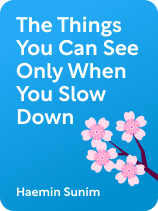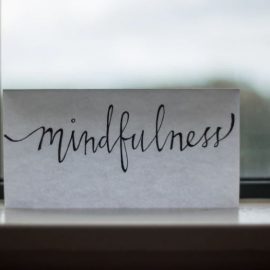

This article is an excerpt from the Shortform book guide to "The Things You Can See Only When You Slow Down" by Haemin Sunim. Shortform has the world's best summaries and analyses of books you should be reading.
Like this article? Sign up for a free trial here.
Do you want to know how to slow down in life? How can you commit to a mindfulness practice?
In his book The Things You Can See Only When You Slow Down, Zen Buddhist teacher Haemin Sunim says mindfulness is an essential tool for slowing down. You must acknowledge that you can’t change external circumstances but you can control your internal responses.
Here’s how to slow down and start living in the moment.
How Can You Practice Slowing Down?
According to Haemin, slowing down isn’t just about physically pausing—it’s also about deliberately shifting your mindset. He explains that to slow down, you must change your internal response to your external world. He suggests taking a more objective, observant stance in response to your environment, interactions, and thoughts. For example, instead of reacting emotionally to a challenging situation, you might step back to observe and analyze it dispassionately, noting details and patterns without immediate judgment. This shift not only enriches your experience of the world but also supports a more balanced and thoughtful approach to life.
(Shortform note: In The Book of Joy, Desmond Tutu and the Dalai Lama discuss how much of human suffering is avoidable because it’s caused by our emotional response to our circumstances. Like Haemin, the Dalai Lama advocates for cultivating equanimity (what he calls “mental immunity”), the ability to maintain a calm and positive state of mind even in the face of adversity. Not only will this help you be more thoughtful, but, according to these two spiritual leaders, cultivating equanimity will help you minimize unnecessary suffering.)
The best way to practice this mental shift, Haemin writes, is to commit to a mindfulness practice.
Commit to a Mindfulness Practice
According to Haemin, mindfulness is an essential tool for slowing down. Mindfulness is the focused awareness of the present, especially of your internal states like thoughts and emotions, without ascribing value or judgment to them. This practice does not mean ignoring your mental and emotional processes but rather recognizing and accepting that they’re temporary. Haemin argues that mindfulness allows you to feel calmer and enriches your experiences by allowing you to savor each moment fully and recognize its fleeting beauty.
(Shortform note: Mindfulness is accessible to anyone. In Wherever You Go, There You Are, mindfulness expert Jon Kabat-Zinn says you can start exactly where you are right now without needing any special equipment or a dedicated space. One of the simplest ways to begin is by paying attention to your breath. By sitting comfortably, closing your eyes if you wish to, and focusing on the natural rhythm of your breath entering and leaving your body, you lay a solid foundation for mindfulness. Another entry point is a body scan. This practice involves systematically focusing on different parts of your body and noticing any sensations without trying to change them, helping to cultivate a deeper awareness of your physical presence.)
According to Haemin, this approach to mindfulness requires a level of detachment that allows you to observe your internal dynamics without judgment. By maintaining this nonjudgmental observation, you’re less likely to be consumed by negative emotions or thoughts, and will be able to acknowledge their presence without allowing them to dictate your reactions.
| How to Manage Strong Emotions Staying detached is one thing in theory, but it’s often more difficult in practice. The RAIN meditation, popularized by meditation teacher and clinical psychologist Tara Brach, is a mindfulness practice designed to help individuals deal with challenging emotions and situations. The acronym RAIN stands for: Recognize: Acknowledge and identify the emotions or thoughts you’re experiencing. Simply notice what’s present, without judgment. Allow: Permit the emotions or thoughts to be there without trying to suppress or change them. Accept them as they are in the moment. Investigate: Explore your feelings with curiosity and openness. Ask yourself questions about the sensations in your body, the triggers for these emotions, and any underlying needs or desires they might reveal. Nurture: Offer yourself compassion and kindness. Provide comfort and support to yourself, as you would to a dear friend. This practice helps cultivate greater emotional resilience and self-awareness by transforming how you relate to your inner experiences. |
Haemin emphasizes that the disciplined practice of mindful observation mitigates the impact of negative thoughts and emotions and also enhances your self-awareness. Knowing your patterns, habits, and emotional triggers allows you to respond more thoughtfully, leaving you better equipped to deal with life’s challenges with equanimity and intention.
(Shortform note: According to Daniel Kahneman, author of Thinking, Fast and Slow, much of our decision-making is automatic, driven by a neurological mechanism he calls System 1. This system operates quickly and with little effort, using intuition and automatic processes. Kahneman suggests that around 95% of our thoughts, emotions, and learning occurs in this subconscious manner without our awareness. Therefore, the majority of our daily decisions are influenced by this fast-thinking system unless we use strategies, like mindfulness, to actively engage the slower, more deliberate System 2 to scrutinize our choices and reactions.)

———End of Preview———
Like what you just read? Read the rest of the world's best book summary and analysis of Haemin Sunim's "The Things You Can See Only When You Slow Down" at Shortform.
Here's what you'll find in our full The Things You Can See Only When You Slow Down summary:
- Why we feel continuously busy and overwhelmed
- How embracing slowness can lead to increased self-awareness and contentment
- The importance of curbing your enthusiasm when pursuing your passion






